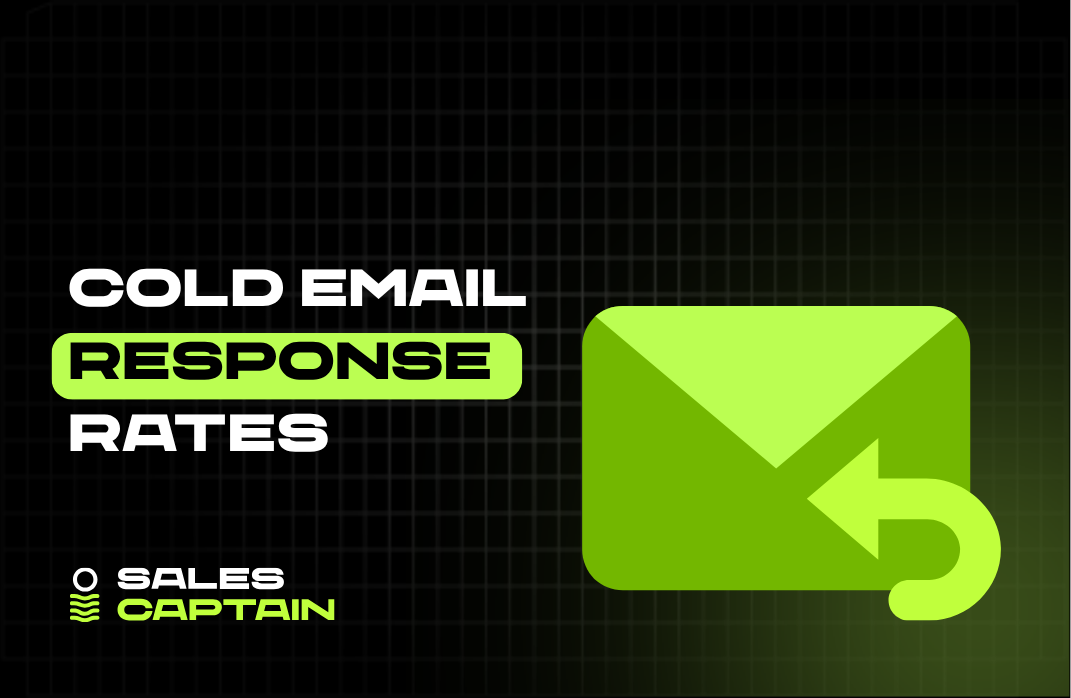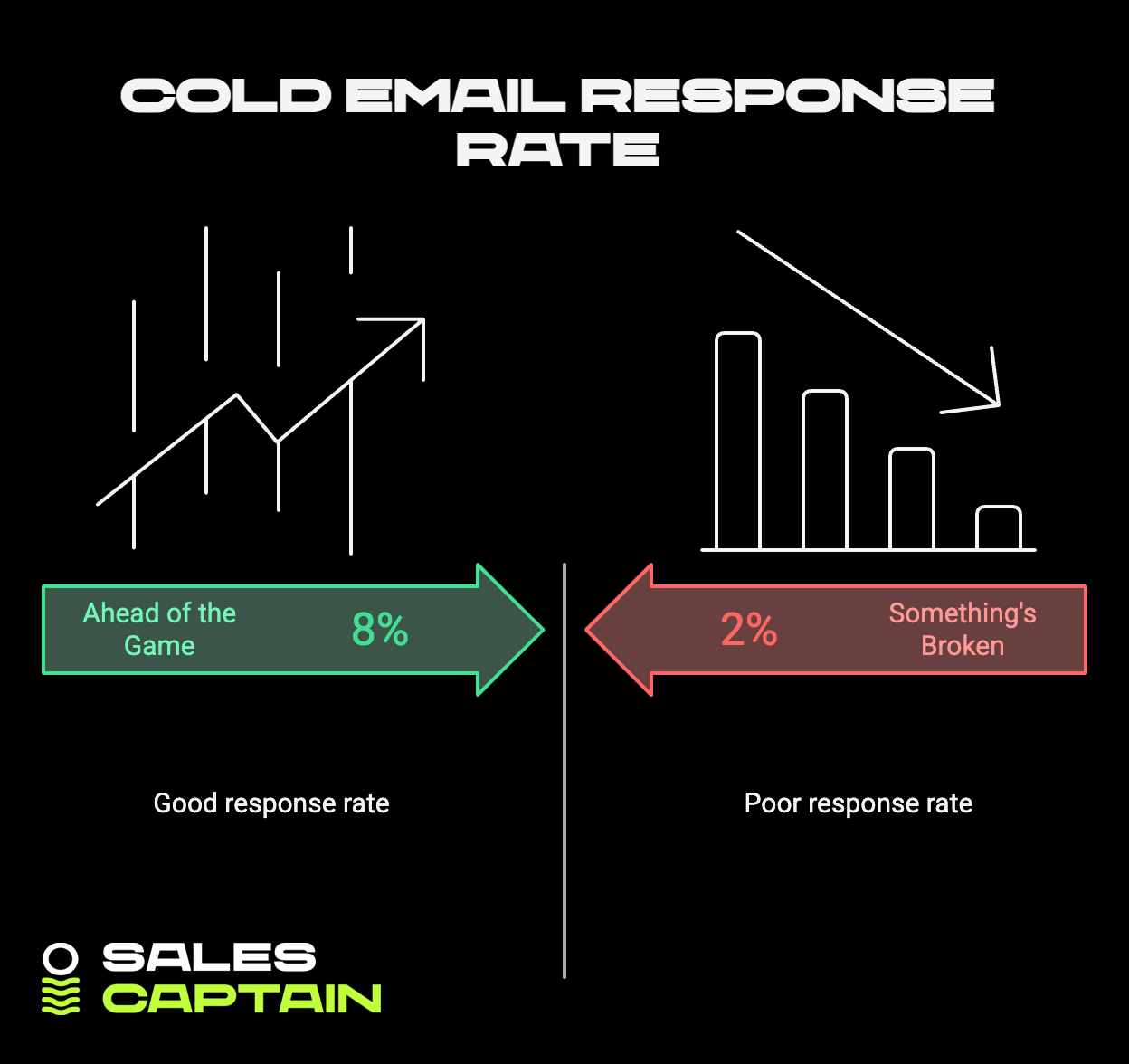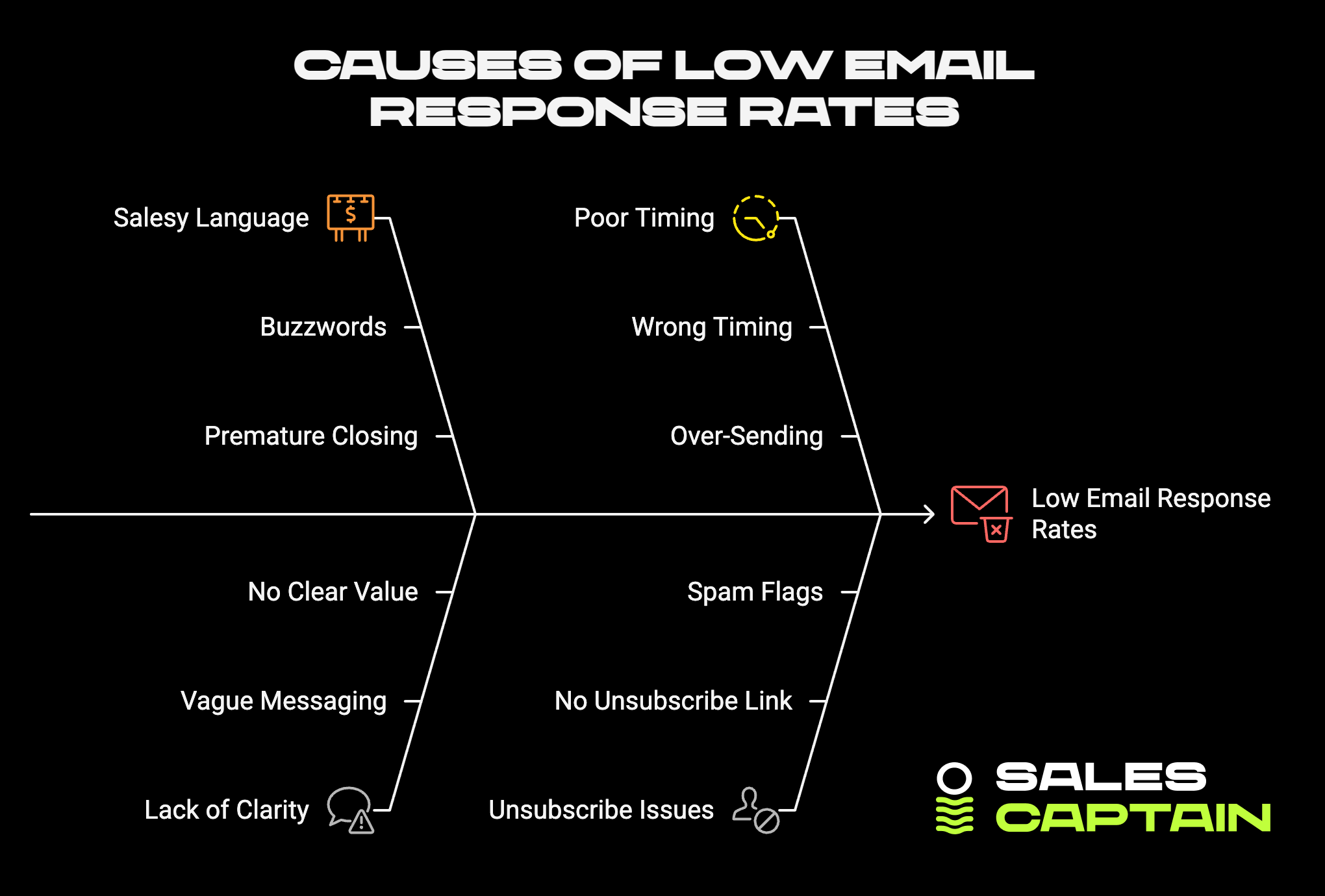

Cold Email Response Rates Explained: Benchmarks, Tactics, and How to Improve


Cold email response rates are more than just numbers. They show whether your message is actually landing or getting ignored. A high open rate means nothing if nobody hits reply. This guide breaks down what response rates really mean, what counts as a good one, and how to improve yours with better targeting, stronger personalization, and clear strategy. No fluff. Just what works.
Understanding Cold Email Response Rates
What is a Cold Email Response Rate?
Cold email response rate measures how many people reply to your unsolicited outreach. That might mean a simple “not interested,” a “let’s talk,” or even an “unsubscribe.” As long as they respond, it counts.
It’s a raw signal of how well your message cuts through noise. Not just how many people opened it, but how many felt compelled to hit reply.
However, keep this in mind: opens and clicks are vanity metrics unless they convert to a pipeline. Response rate is the early proxy for downstream results.
Average Cold Email Response Rates
The average cold email response rate across industries typically falls between 1% and 5%. Well-optimized campaigns? They can push that into the 8–12% range.
But blanket numbers lie.
A founder reaching out to other founders with a clear value exchange can see 20%+ response rates. A mass-blasted list of scraped leads with no personalization? You’ll be lucky to crack 0.5%.
The average doesn’t matter if your list is misaligned or your message lacks intent. Measure your baseline, then optimize from there.
Factors Influencing Response Rates
Industry Variations
Some sectors naturally bite harder. SaaS buyers, tech execs, and founders are conditioned to cold outreach, and some even welcome it if the pitch is strong. Others, like healthcare or government? Brick walls.
Your ICP’s email culture shapes expectations. You’ll never get the same engagement from a DTC retail buyer as you would from a growth-minded VP of Marketing who knows outbound is now a core channel.
Quality of Contact Lists
Your list is everything. You could write the best cold email ever, but if it’s going to people with no buying power or intent, it’s dead on arrival.
Bad data breaks response rates before your email is even opened. Role accuracy, industry relevance, and firmographic fit all matter. Tools like Clay let you build signal-rich lists, think buying triggers, tech stacks, and hiring patterns, not just job titles and company sizes.
Good outbound starts with precision. Not volume.
Email Personalization and Relevance
You can’t fake relevance. If your message feels lifted from a template, it gets archived. Fast.
The delta between a 2% and a 10% reply rate often comes down to simple personalization. Mentioning a shared connection, referencing their recent funding round, or aligning your value prop with their current priorities, all of it compounds.
AI makes this scalable. The bottleneck now isn’t data or writing. It’s a strategy.
Generic messaging tank response. Relevance drives it.
Setting Benchmarks

What Constitutes a Good Response Rate?
If you’re getting above 8%, you’re ahead of the game. Below 2%? Something’s broken, list quality, your messaging, or both.
But more important than the number is the feedback loop. Are responses turning into meetings? Are meetings moving to the pipeline?
Outbound isn’t static anymore. Performance is a moving target. Use response rate as your early warning system, not the final scoreboard.
Comparison with Other Outreach Methods
Cold Email vs. Cold Calls
Cold calls are interruptive. Cold emails are asynchronous. The former punches through if your timing is perfect. The latter sits there, waiting to be opened, forwarded, or ignored.
Response rates on cold calls might feel higher because conversations happen in real time. But cold emails have longer shelf lives and reach more people with less effort.
Also, emails create written artifacts. Forwardable. Searchable. Easier to analyze. In today’s GTM systems, outbound isn’t about one channel; it’s about orchestration.
Cold email is the most scalable outbound surface if your inputs are dialed in.
Cold Email vs. LinkedIn Messages
LinkedIn InMails feel personal. Until they don’t.
They work well for high-trust, lower-volume outreach. But scaling InMails is tough. You hit character limits, platform friction, and spam filters.
Cold email is still where most outbound scale happens. And in a world where AI lets you personalize thousands of emails at once, email wins on leverage.
Plus, LinkedIn inbox fatigue is real and way more brutal.
Strategies to Boost Cold Email Response Rates
Importance of Personalization
Templates are fast. Personalization gets replies.
This doesn’t mean writing a snowflake message for every prospect. It means layering context into your outreach efficiently.
Personalization signals effort. It shortcuts skepticism. It tells your prospect, “This isn’t a mass blast, I did my homework.”
Techniques for Personalizing Emails
- Reference a recent company event (like fundraising or a key hire).
- Mention a shared community, podcast, or newsletter.
- Build messaging around their tech stack or job responsibilities.
- Use Clay or similar tools to inject dynamic, persona-specific lines at scale.
It’s not about copying their LinkedIn bio. It’s about threading relevance into your pitch. Don’t flatter, connect.
Examples of Effective Personalization
- “Saw you’re hiring your first RevOps lead, which is usually a sign that TM complexity is increasing. We help early-stage teams simplify segmentation and workflows.”
- “Heard your episode on the Exit Five podcast. Loved your take on attribution. We built something aligned with what you described.”
The goal isn’t to impress. It’s to earn the reply.
Crafting Compelling Subject Lines
Subject lines are the gatekeepers. If yours doesn’t spark curiosity or look human, your open rate (and thus response rate) will tank.
Avoid clickbait. Instead, aim for clarity, relevance, and just enough intrigue.
Examples:
- “Quick question about [prospect’s company]”
- “Saw your new role, had an idea”
- “Experimenting with ICP targeting?”
Think less like a marketer, more like someone trying to start a conversation.
Structuring Your Email for Maximum Impact
Once they open, you’ve got 3 seconds to earn the scroll. Your email needs to do one job: create enough intrigue to get a reply or a click.
Keeping It Concise
No walls of text.
Write like a smart, busy person wrote it. Cut filler. Break lines. Make it skimmable.
Aim for 50–125 words, tight, respectful of their time, and easy to respond to.
Including a Strong Call-to-Action
Don’t waffle.
Ask one thing. Be specific. Time-bound CTAs work. So do binary questions like: “Worth a chat?” or “Is this on your radar?”
Avoid: “Let me know if you want more info…”
Try: “Open to a quick 10-min call next week to unpack this?”
Be human. But also be direct.
Utilizing Follow-Up Emails
One email isn’t a campaign. Most replies happen in the follow-up sequence. Not the first send.
The magic is in the persistence, with respect.
Optimal Timing for Follow-Ups
Great timing = higher response.
Standard rhythm is 3–4 days after the first send, then space them out. Aim for a 3–4 touch sequence across 2–3 weeks.
Early touches should add new context or value. Later ones can be short, conversational nudges.
Follow-Up Best Practices
- Don’t just bump the thread. Add something new, a new insight, stat, or angle.
- Change the subject line if the previous one flopped.
- Keep them short. 2–3 lines max.
- Stop at 4–5 total touches unless there’s engagement. Then switch channels or pause.
Follow-ups are where outbound turns from message blast into a campaign. Treat them like assets, not afterthoughts.
Common Pitfalls and What Decreases Response Rates

Overly Salesy Language
Buzzwords kill replies. Nobody wants a “synergistic solution for scalable growth.” Write like a human. Not a pitch deck.
If your email feels like it’s closing before the conversation starts, it’s dead.
Keep discovery separate from pitching.
Lack of Clarity in Messaging
If they can’t figure out what you’re offering in 10 seconds, they won’t spend eleven.
Don’t be vague. Don’t make them piece it together. Say what it is, who it’s for, and why it matters, to them.
Clarity beats clever every time.
Poor Timing and Frequency of Emails
Blasting at the wrong time kills momentum. Friday afternoons? Trash bin. Monday mornings? Buried. Try midweek, mid-morning, or even Sunday evenings for execs.
Once you’ve scheduled the first wave, test different timing windows across your segments.
Also, don’t over-send. If you’re touching someone every two days with no engagement, you’re burning goodwill.
Ignoring Unsubscribe and Spam Issues
No unsubscribe link? Spam filters notice. So do your prospects.
Negative signals pile up fast. Too many bounces, spam flags, or “this isn’t relevant” replies, and soon your entire domain suffers.
Keep your domain warm. Rotate senders if needed. Get technical with it, or work with a demand generation agency like SalesCaptain that handles infrastructure right from day one.
Analyzing and Calculating Your Response Rate
How to Calculate Cold Email Response Rates
Simple formula:
Response Rate = (Number of Replies / Emails Sent) x 100
If you send 1,000 emails and get 68 replies, your response rate is 6.8%.
Doesn’t matter if the reply is “no thanks”, you wanted a reply, and you got it.
Just make sure:
- You’re only counting first-touch responses, not replies down a thread.
- Bounces are excluded from email counts if you want cleaner analysis.
Understanding Positive vs. Negative Replies
All replies are not created equal.
Track your response rate, sure, but separate the “not interested” from the “let’s talk” replies. Push them into two buckets:
- Positive replies: interest shown, meeting booked, referral given.
- Negative replies: polite pass, unsubscribe, or disinterest.
Why it matters: If your reply rate’s high but all responses are negative, your targeting or messaging is off. If they’re all warm? You’re onto something big.
Using performance dashboards helps you get granular here, and this is where outbound becomes a system, not just a tactic. Feedback loops turn into next steps.## Best Practices for Successful Cold Email Campaigns
Segmentation of Email Lists
One-size-fits-all outreach doesn’t work. If your entire list gets the same message, your response rate’s capped before it even hits "send."
Segmentation flips the script. It lets you tailor campaigns based on real traits: job titles, tech stack, growth stage, hiring signals, company size, geo, and specific pain patterns.
Think like a technical marketer, not a mass-blaster:
- Match messaging to ICP slices, not broad buckets.
- Split personas into smaller high-signal clusters, like RevOps at Series B SaaS vs Growth leads at bootstrapped PLG companies.
- Align tone and CTA to the prospect’s role and motion.
This isn’t just a sales strategy, it’s outbound infrastructure. The better your segmentation, the less your email feels like a cold one.
A/B Testing for Email Variations
Guesswork is expensive. A/B testing is your insurance policy.
Test subject lines, CTAs, intro lines, length, tone, and formatting. But don’t test just to test, test with a purpose.
What to watch:
- Does humor outperform curiosity?
- Is “quick question” better than a value-driven hook?
- Do short, blunt CTAs outperform softer phrasing?
Set one variable per test. Give it volume. Let the stats lead.
Once a variation wins, promote it system-wide. Let it inform copy frameworks, not just one campaign.
Outbound isn’t craft anymore, it’s performance marketing. A/B test like one.
Continuous Improvement through Analytics
Outbound without analytics is flying blind.
You need dashboards that don't just show responses; they show patterns. What personas reply most? Which templates convert to calls? Are certain subject lines triggering Gmail tabs?
Track micro metrics:
- Weekday/time heatmaps
- Bounce % by source
- Reply intent (positive vs negative)
Look macro too:
- Which sequences convert to pipeline?
- Which reps or systems outperform the rest?
Outbound is no longer just about hustle. It's about loops, data-driven feedback loops that close the gap between guess and growth.
Treat every campaign like a product launch. Ship, measure, iterate. That’s how you scale a response rate from 3% to 12%.
Resources and Tools
Recommended Software for Cold Email Campaigns
Let’s be clear, tech stack matters. Sending cold emails at scale without the right software leads to deliverability misery and broken pipelines.
Start with Clay if you're serious about list quality. It lets you build enriched lead lists using live signals, tech used, hiring intent, funding, and way more. The gold is in triggers, not titles.
For outbound sequencing? Tools like Smartlead, Instantly, or Apollo do the job. Smartlead shines with high-volume deliverability. Instantly’s known for its ease of use.
But tools are only as good as the operators. The best stacks blend backend logic (like Clay) with strong sequencing and inbox monitoring.
If you’re shipping outbound as part of your GTM engine, think beyond tooling, think system.
Tools for Tracking Open and Response Rates
Measurement drives movement. You can’t improve cold email performance unless you’re tracking meaningful signals.
Look for tools that:
- Separate opens, clicks, replies, and positive intent
- Attribute replies to specific sequences and steps
- Flag spam issues before they cause damage
Most cold email platforms offer some level of analytics. But for deeper insight, plug into integrations like Google Postmaster Tools (for domain health) or Gmass for inbox placement testing.
Bonus: Layer in analytics platforms like Supermetrics or Looker Studio if you want to build custom dashboards across channels and campaigns.
Your response rate is just the surface. Great data infrastructure tells you why things work or crash.
Additional Reading and Guides
Want to go deeper?
- The Cold Email Masterclass by Josh Braun: Solid breakdowns of structure, psychology, and objection handling.
- Predictable Revenue by Aaron Ross: A legacy read, but great for understanding SDR systems and outbound flow architecture.
- Grow & Convert’s Content-Driven Outbound Essays: Especially good for marketers layering intent data into cold emails.
- SalesCaptain’s Playbooks: No-fluff guides from an outbound agency that’s engineered campaigns for dozens of B2B startups.
These aren't fluff PDFs or Twitter threads. They're signal-rich, tactical, and meant for people who ship.
FAQs
Below 2% is a red flag.
You’re not getting sa ignal, which usually means:
- Poor list quality (wrong ICP, stale data)
- Bland messaging or zero personalization
- Deliverability issues (spam filters, bad sending infrastructure)
1–2% might be salvageable. Under 1%? You need a full teardown, not just a subject line tweak.
Compare across industries, but optimize against your baseline. Some niches top out at 5%; others can do 15%+ with intent-driven sourcing.
Start with 3–4 days after the first email. That gives enough breathing room without going cold.
Then play the sequence over 2–3 weeks with spacing like:
- Day 4
- Day 8
- Day 12
- Day 18 (if needed)
Each touch should feel like a new layer, not just a bump. If you’re not adding value or context, you’re just nagging.
Track reply rates across steps, not just the first one. Often, follow-up 2 is where the magic kicks in.
Personalization is about relevance, not flattery.
Here’s how to thread it in:
- Reference recent events (funding, product launch, hiring surge)
- Align with their tech stack (“Looks like you’re using Segment, noticed teams struggle with attribution in that setup”)
- Engage with their public voice (podcast, post, substack)
Use variables, yes. But let strategy drive them. A sentence crafted with insight beats five tokens stuffed into a template.
The goal is: “This feels just for me” while still shipping at scale.
Yes, in both directions.
Used well, humor disarms. It signals confidence. A witty line in the right industry (think creative, SaaS, or marketing) can boost opens and replies.
But go too far, and it backfires. If your joke falls flat or sounds tone-deaf, you kill trust.
The rule: Use humor sparingly, and only if you understand your ICP’s culture. Humor is seasoning, not the main course.
Experiment, A/B test it, and don’t force it. “Funny” should never come at the cost of clarity.
If you’re seeing decent open rates, then sudden silence, something’s off.
Check for these signs:
- High bounce rates (10%+ is a no-go)
- Sudden drop in responses despite the same list quality
- Messages landing in “Promotions” or never delivering
Use inbox placement tools (like GlockApps or Mailreach) to test where you're landing. Also, check Google Postmaster Tools or Microsoft SNDS for sender reputation signals.
Spam isn’t just a content issue, it’s infra. Warm your domain, rotate aliases, throttle volume, keep headers clean, and track complaint rates carefully.
Cold email isn’t about scale first; it’s about trust at scale. Spam kills that instantly.
RELATED ARTICLES
Check out more articles on our blog!
RELATED ARTICLES
Lorem ipsum dolor sit amet, consectetuer adipiscing elit, sed diam nonummy nibh euismod tincidunt ut laoreet dolore magna aliquam erat volutpat.
.png)
.png)


.jpg)





